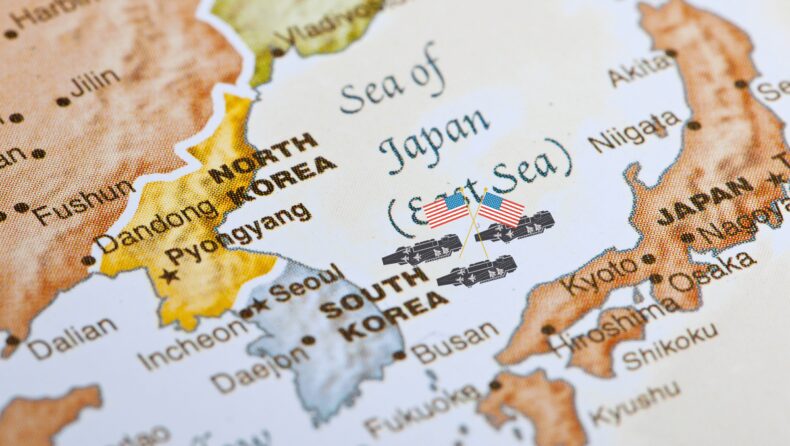On Sunday, March 12, the Korean Central News Agency (KCNA) reported that North Korea test-fired two strategic cruise missiles from a submarine.
The testing comes just as US-South Korea military drills are set to begin. “Strategic” is generally used to describe weapons that have nuclear capability. KCNA stated that the launch of the two missiles established the reliability of the system, and the underwater offensive operations of the submarine units.
WHY IS NORTH KOREA REACTING THIS WAY?
North Korea regards the joint drills as a rehearsal for invasion. Drawing strength and confidence from its advancing nuclear arsenal, North Korea has test-fired more than 70 missiles in the last year. Many of the missiles were used to test nuclear-capable weapons that could strike the US mainland and South Korea. North Korea has also threatened the US and South Korea with pre-emptive use of its nuclear weapons in case of a potential conflict between the two countries.

Last month, the North Korean Foreign Ministry warned the US and South Korea of “unprecedentedly determined and strong counteractions” if they went ahead with the joint drills. According to KCNA, the cruise missiles that were launched on Sunday from the 8.24 Yongung ship flew for more than two hours and hit targets more than 1500 kilometres away. The launch details put US military bases in Okinawa within striking distance if launched from North Korea’s eastern waters. The command of a submarine-launched missile system will make it difficult for its rivals to detect launches in advance and will provide North Korea with retaliatory attack capabilities.

Experts say that North Korea is trying to pressure the United States into accepting it as a nuclear-capable nation and easing the international economic sanctions imposed on it. North Korea views its nuclear arsenal as its best security guarantee and uses its rivals’ drills as a pretext to conduct missile tests and modernise its nuclear arsenal while aiming to complete its nuclear triad.
FREEDOM SHIELD 23
American and South Korean troops were scheduled to begin joint drills on Monday, March 13. The drills have been dubbed “Freedom Shield 23” and will take place over a span of 11 days. The drills are expected to strengthen the combined defensive posture of the two allies. The exercises will include computer-simulated command post training and joint field training, including amphibious landings.

The US military recently issued a statement that said the field exercises will further enhance the two militaries’ cooperation through air, land, sea, and cyber operations.
SOUTH KOREA’S REACTION
North Korea’s nuclear triad is a source of great unease for its neighbour, South Korea. South Korea’s Joint Chiefs of Staff (JCS) stated that the military has been put on high alert and the specifics of the launch are being analysed by the country’s intelligence agency along with its US counterpart.
Koo Byoung-sam, spokesperson for South Korea’s unification ministry, said in a statement that it was very “regretful” that North Korea was using regular, defensive drills as pretext for provocation, and that there was nothing to gain from escalating tensions in the Korean peninsula.

Oh Se-hoon, the mayor of Seoul, has been advocating for a South Korean nuclear weapons programme. A likely contender for the presidency in 2027, Oh Se-hoon, is part of a growing number of senior South Korean officials who have doubts over the US’s commitment or ability to protect South Korea amid North Korea’s military advances. This group has raised the possibility of developing a nuclear weapons programme or redeploying American tactical nuclear bombs. According to a poll released by Data Research in the first week of March, more than 70% of citizens supported developing nuclear weapons.
HOW DOES THE US FACTOR IN?
The United States has been a key player in the region since the Korean War, providing military support to South Korea and maintaining a strong presence in the region. The US has also been a vocal opponent of North Korea’s nuclear program, imposing economic sanctions and conducting military exercises with South Korea. There have been some diplomatic efforts, including the 2018 summit between US President Donald Trump and North Korean leader Kim Jong-un, but these talks have not led to a significant breakthrough in resolving the nuclear issue. There have also been instances of heightened tension and military posturing between the United States and North Korea, including missile tests and military exercises.

North Korea’s advances in nuclear weapons and missile capabilities have catapulted Pyongyang from a threat to US interests in Asia to a direct threat to the US homeland. In 2022, Kim declared that North Korea would never denuclearize. The Biden Administration is pursuing a “calibrated, practical approach” with North Korea and is open to a diplomatic solution.













